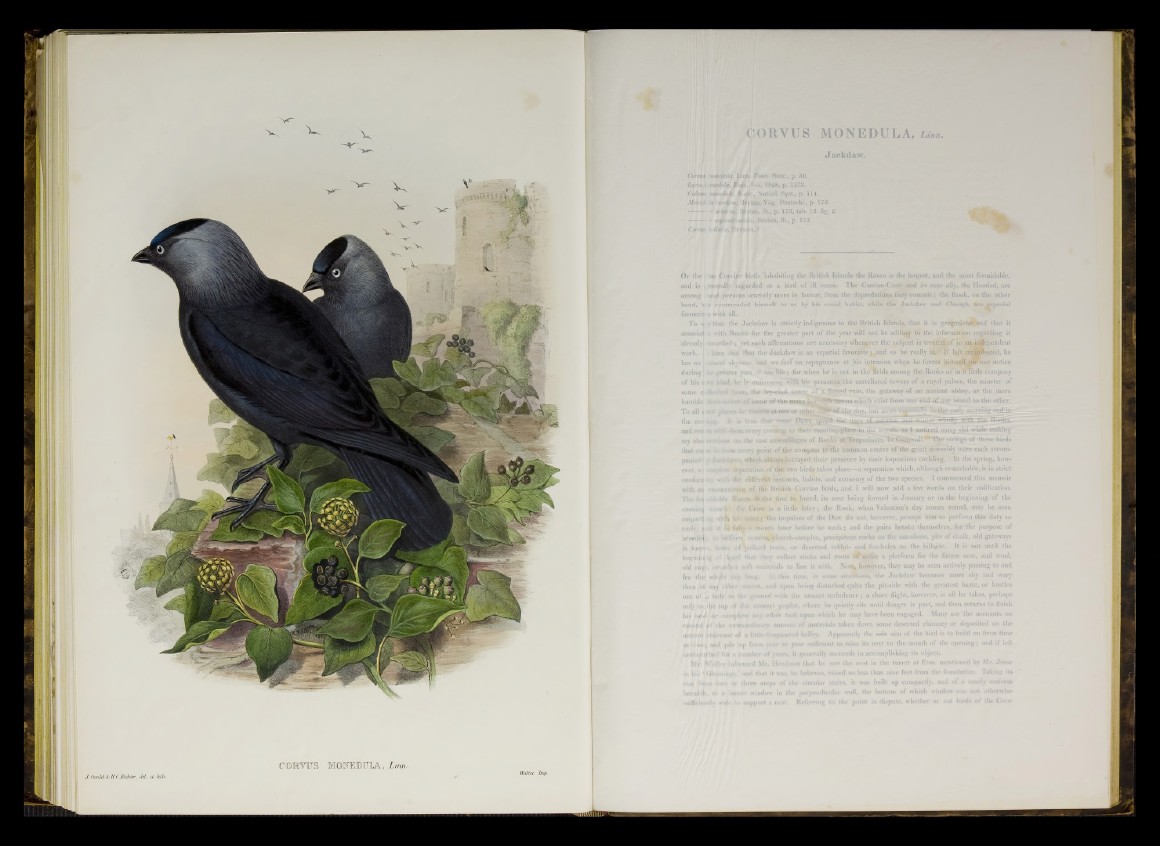
J . (m ild k IT C Jùehtfr del ct litiv
COMFITS MOHEDUIA, Zirav
Waller, Imp.
j'ORYUS MONEDULA, Linn.
J ackdaw.
Carws mnedula, Liimj Faun. Suée., p. 30.
Lycps^ ine^ila, Boie,!.UIs: 1323, p. 1273.
Gokain mmedujkf, Kai p, Natiirt Syst., p. 114.
M é k !'t am- m, Wféhsa, Vög. Deutschl., p. 172.
#% ? { -• «rU rea ; Bbarc. p. 173, tab. 12. fig. :
»1 * sep/-Hif j*s, Brehm, ib., p. 173.
Of the uc Corvin.’.' birds£ inhabiting the British Islands the Raven is the largest, and the most formidable,
and is eoeraHy regarded as a bird of ill omen. The Carrion-Crow aud its near ally, the Hooded, are
among : iost persons .scarcely more in favour, from the depredations they commit; the Rook, on the other
hand, li s commended himself to us by his social habits, while the Jackdaw aud Chough arc especial
favourit
■ To J .
associai
work,
has no
during !
of his {
some df
humble
To all {■
the evd
and ret
my obs-
that ea
panied
i with all.
f that the Jackdaw is strictly indigenous to the British. Islands, that it is gregarious,¥ and that it
. with Rooks for the greater part of the year will -not be adding to the information regarding it
worded .• yet such affirmations are necessary whenever the ..subject is treate.d.of m an independent
have *aid that the Jackdaw is an especial favourite j^and so he really isvT If left unttfplested, he
■ • arai sh>; • kmI we feel no repugnance at his intrusion when he forces himself :.oir our: notice
w greater pari - u» fife; for when he is not in the fields among the Rooks or in a little company
m kind, he is enim-moc wfth his presence, the castellated towers of a royal palace, the minster of
town, the iw-eiad u>.wer of a famed ruin, the gateway of an ancient abbey, or the more
if some of the nmny^uoi&'T*!'! towns which exist from one end of our island to the other.
orts at one or other
Baft
coque* i dot hfel
early, à •;*! it Id full
hreeiiti? <■> Mdfriei
in tOWlj >■. JViilirr.k of
begin» ij'it o* .Vonl
old rag». ar-ittficr
fro thej vviipi » Puj
than a t any .‘ther
ont of a! hole in tl
onlv co /lie top of *
his /aèsi' or coippli
record: of the
p*
o f the day, hui. mûre espéi iolly i» the early morniinr and 1b _
r-felie ijfjy^ oil -...'.-¿.Ziivi wiMpy wiLlf
em every evening to their roosting-place in the vvowd* as 1 aoticediiiauy did whilemakfftg'
an the vast assemblages of Rooks ai Tregoth nan, ib Cornwall. > The strings of these birds
i every pointof the compass to the common centre o f the greafasserobly were each accom-
, s, which alwaysbetrayed their presence by their loquacious cackling. In the spring, how-
tëparation of the two birds takes place-^-a separation which, although remarkable, is in strict
hé different instincts, habits, and economy of the two species. I commenced this memoir
■;on of the British Corvine birds, and I will now add a few words on their nidification,
lave« is the first to breed, its nest being formed in January or in the beginning of the
'Jtr Crow is a little later ; the Rook, when Valentine’s day comes round, may be seen
(ate ; the impulses of the Daw do not. however, prompt him to perform this duty so •
■ g month later before he weds; and the pairs betake themselves, for the purpose of
., ( •1 vers, ehurch-steeples, precipitous rocks on the sea-shorc, pits of chalk, old gateways
Siorwrd trees, or deserted rabbit- and fox-holes on the hillside. It is not until the
that they collect sticks and roots to make a platform for the future nest, and wool,
voft materials to line it with. Nont, however, they may be seen actively passing to and
long. At this time in some situations, the Jackdaw becomes more shy and wary
•HMton, and upon being disturbed quits the pit-side with the greatest haste, or bustles
ground with the utmost turbulence ; a short flight, however, is all he takes, perhaps
Ite - - arest poplar, where he quietly sits until danger is past, and then returns to finish
te any other tank upon which he may have been engaged. Many are the accounts on
Lordiuary amount of materials taken down some deserted chimney or deposited on the
a littk-frequented belfry. Apparently the sole aim of the bird is to build on from time
p from year to year sufficient to raise its nest to the mouth of the opening ; and if left
umber of years, it generally succeeds in accomplishing its object.
•uied Mr. How if son that he saw the nest in the turret at Eton mentioned
and that it was, he believes, raised no less than nine feet from the fouudaii.
three steps of the circular stairs, it was built up compactly, and of a
It window in the perpendicular wall, the bottom of which wiudow was
support a nest. Referring to the point in dispute, whether or not bird
xtr;
r Mr. Jesse
Taking its
rly uniform
f the Crow